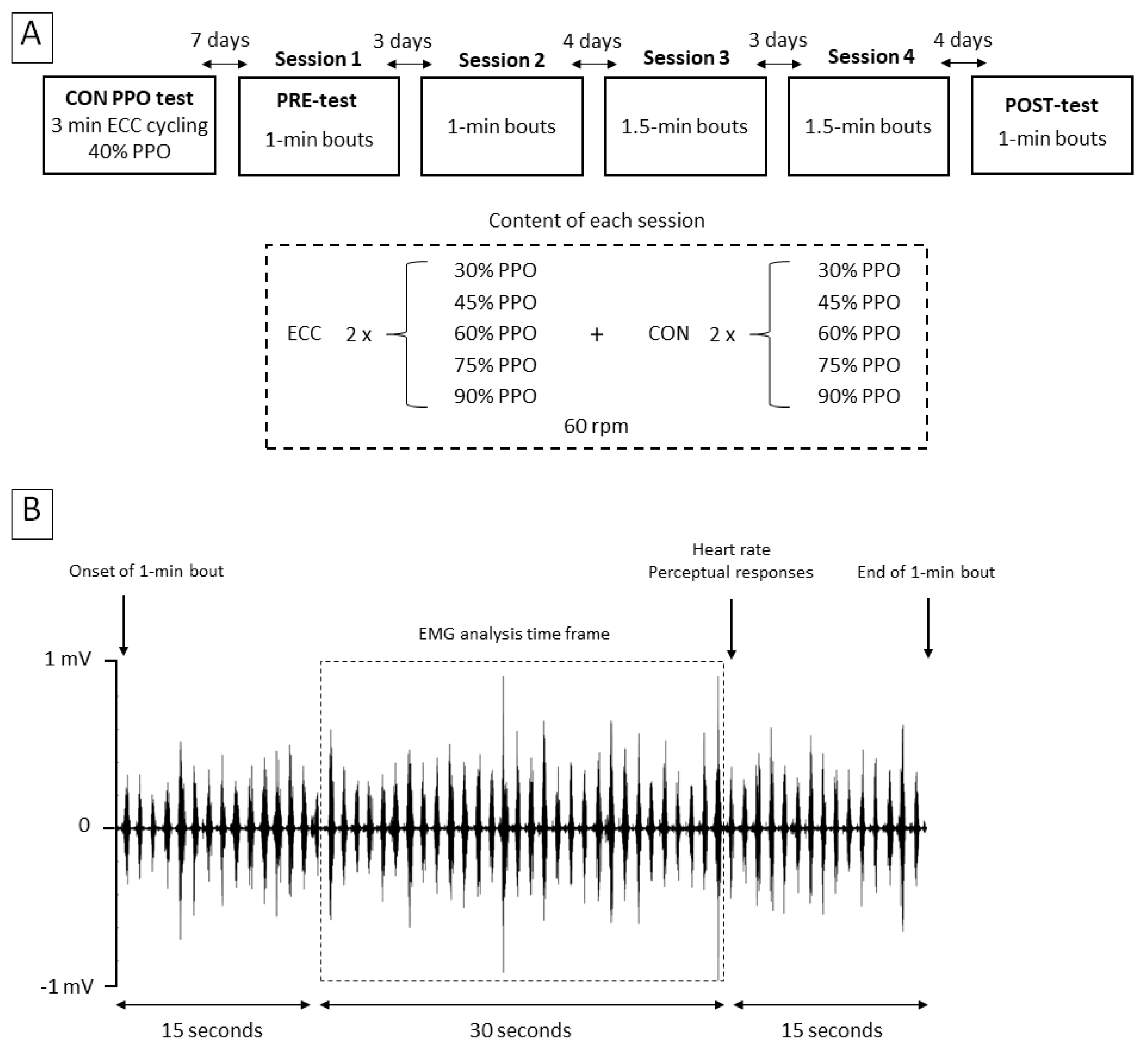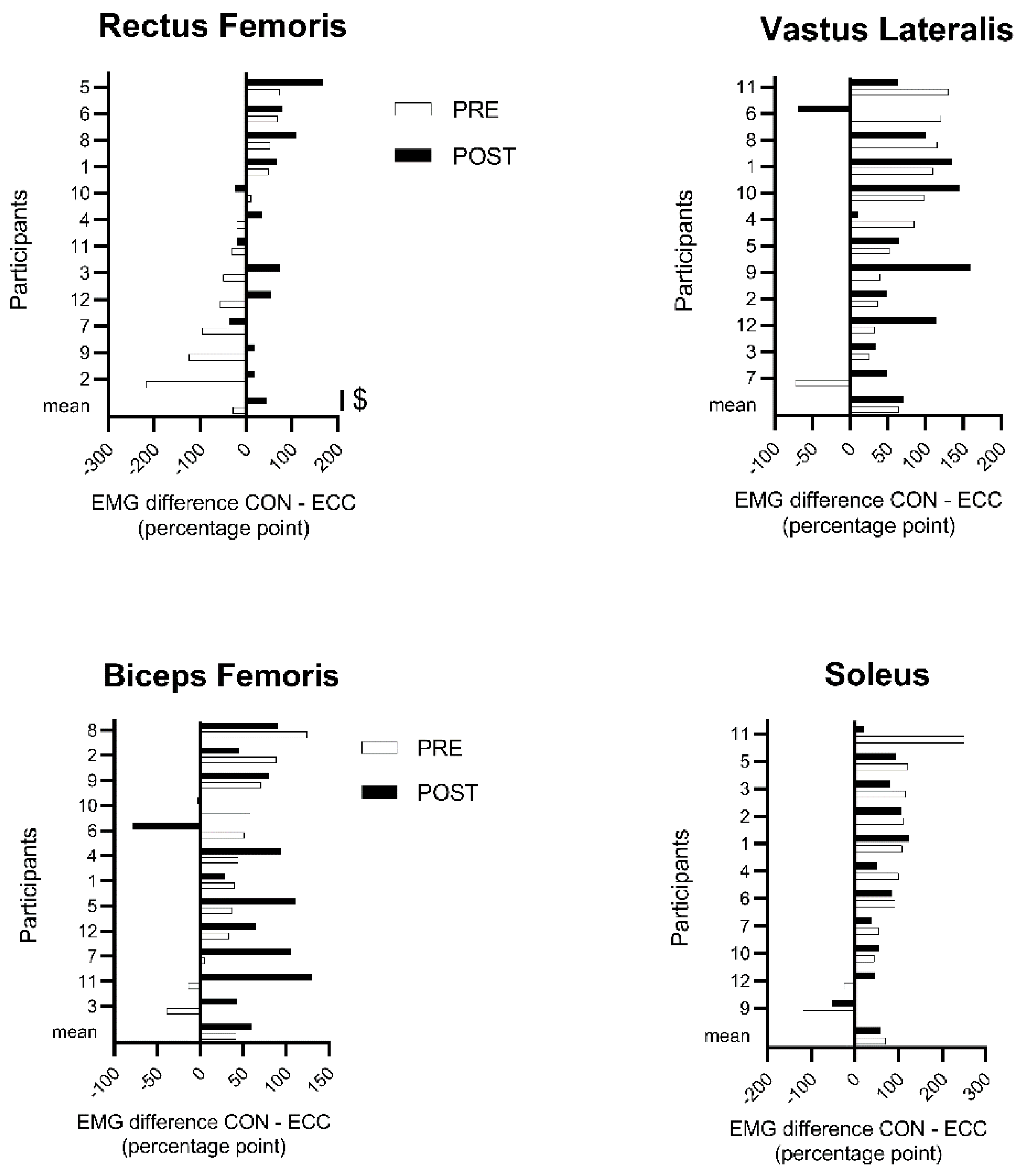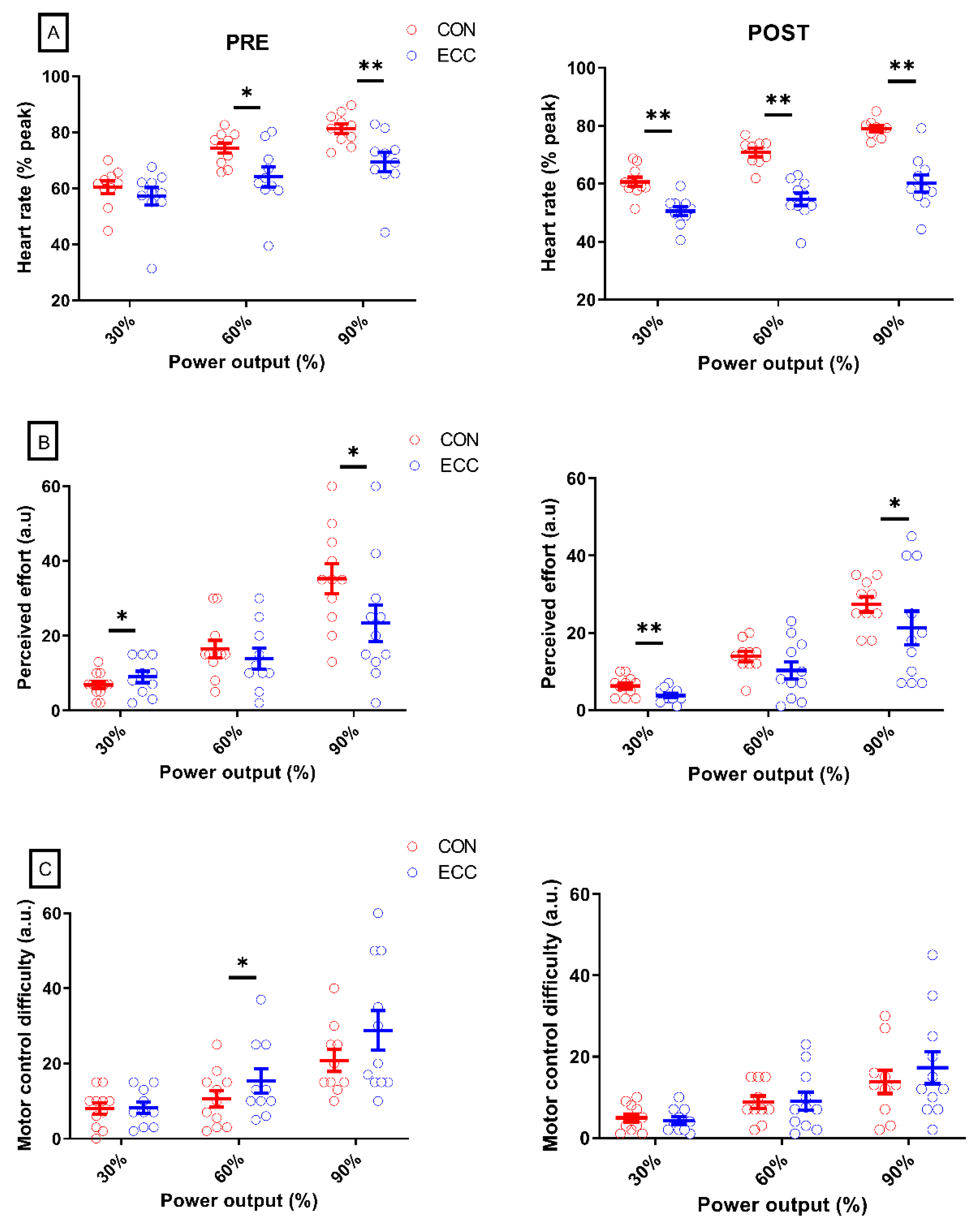Leg Muscle Activity and Perception of Effort before and after Four Short Sessions of Submaximal Eccentric Cycling
Abstract
1. Introduction
2. Material and Methods
2.1. Participants
2.2. Experimental Approach
2.3. Physiological Measurements
2.4. Perceptual Measurements
2.5. Data Analysis
2.6. Statistical Analyses
3. Results
3.1. Muscle Activity
3.2. Heart Rate
3.3. Perceptual Responses
3.4. Heterogeneity of the Responses
4. Discussion
4.1. Changes in Leg Muscle Activity
4.2. Changes in Perceptual Responses and Heart Rate
4.3. Variability of the Responses
4.4. Limits and Perspectives
5. Conclusions
Author Contributions
Funding
Conflicts of Interest
References
- Besson, D.; Joussain, C.; Gremeaux, V.; Morisset, C.; Laurent, Y.; Casillas, J.-M.; Laroche, D. Eccentric training in chronic heart failure: Feasibility and functional effects. Results of a comparative study. Ann. Phys. Rehabil. Med. 2013, 56, 30–40. [Google Scholar] [CrossRef] [PubMed]
- Chasland, L.C.; Green, D.; Maiorana, A.J.; Nosaka, K.; Haynes, A.; Dembo, L.G.; Naylor, L.H. Eccentric Cycling: A Promising Modality for Patients with Chronic Heart Failure. Med. Sci. Sports Exerc. 2017, 49, 646–651. [Google Scholar] [CrossRef] [PubMed]
- Ritter, O.; Isacco, L.; Rakobowchuk, M.; Tordi, N.; Laroche, D.; Bouhaddi, M.; Degano, B.; Mourot, L. Cardiorespiratory and Autonomic Nervous System Responses to Prolonged Eccentric Cycling. Int. J. Sports Med. 2019, 40, 453–461. [Google Scholar] [CrossRef] [PubMed]
- Hoppeler, H. Moderate Load Eccentric Exercise; A Distinct Novel Training Modality. Front. Physiol. 2016, 7, 483. [Google Scholar] [CrossRef] [PubMed]
- Laroche, D.; Joussain, C.; Espagnac, C.; Morisset, C.; Tordi, N.; Gremeaux, V.; Casillas, J.-M. Is It Possible to Individualize Intensity of Eccentric Cycling Exercise From Perceived Exertion on Concentric Test? Arch. Phys. Med. Rehabil. 2013, 94, 1621–1627.e1. [Google Scholar] [CrossRef]
- Vieira, D.S.R.; Baril, J.; Richard, R.; Perrault, H.; Bourbeau, J.; Taivassalo, T. Eccentric Cycle Exercise in Severe COPD: Feasibility of Application. COPD J. Chronic Obstr. Pulm. Dis. 2011, 8, 270–274. [Google Scholar] [CrossRef]
- Lewis, M.C.; Peoples, G.E.; Groeller, H.; Brown, M.A. Eccentric cycling emphasising a low cardiopulmonary demand increases leg strength equivalent to workload matched concentric cycling in middle age sedentary males. J. Sci. Med. Sport 2018, 21, 1238–1243. [Google Scholar] [CrossRef]
- Tesch, P.A.; Dudley, G.A.; Duvoisin, M.R.; Hather, B.M.; Harris, R.T. Force and EMG signal patterns during repeated bouts of concentric or eccentric muscle actions. Acta Physiol. Scand. 1990, 138, 263–271. [Google Scholar] [CrossRef]
- Lechauve, J.; Perrault, H.; Aguilaniu, B.; Isner-Horobeti, M.; Martin, V.; Coudeyre, E.; Richard, R. Breathing patterns during eccentric exercise. Respir. Physiol. Neurobiol. 2014, 202, 53–58. [Google Scholar] [CrossRef]
- Bigland-Ritchie, B.; Woods, J.J. Integrated electromyogram and oxygen uptake during positive and negative work. J. Physiol. 1976, 260, 267–277. [Google Scholar] [CrossRef]
- Peñailillo, L.; Blazevich, A.J.; Nosaka, K. Factors contributing to lower metabolic demand of eccentric compared with concentric cycling. J. Appl. Physiol. 2017, 123, 884–893. [Google Scholar] [CrossRef] [PubMed]
- Dufour, S.P.; Doutreleau, S.; Lonsdorfer-Wolf, E.; Lampert, E.; Hirth, C.; Piquard, F.; Lonsdorfer, J.; Geny, B.; Mettauer, B.; Richard, R. Deciphering the metabolic and mechanical contributions to the exercise-induced circulatory response: Insights from eccentric cycling. Am. J. Physiol.-Regul. Integr. Comp. Physiol. 2007, 292, R1641–R1648. [Google Scholar] [CrossRef] [PubMed]
- LaStayo, P.; Pifer, J.; Pierotti, D.; Lindstedt, S. Electromyographic Adaptations Elicited by Submaximal Exercise in Those Naive to and in Those Adapted to Eccentric Exercise: A descriptive Report. J. Strength Cond. Res. 2008, 22, 833. [Google Scholar] [CrossRef] [PubMed]
- Pageaux, R.; Lepers, R.; Casillas, J.-M.; Laroche, D. It is time to investigate acute and chronic perceptual responses to eccentric cycling. J. Appl. Physiol. 2017, 123, 1416–1417. [Google Scholar] [CrossRef]
- Perrey, S.; Betik, A.; Candau, R.; Rouillon, J.D.; Hughson, R.L. Comparison of oxygen uptake kinetics during concentric and eccentric cycle exercise. J. Appl. Physiol. 2001, 91, 2135–2142. [Google Scholar] [CrossRef]
- Clos, P.; Laroche, D.; Stapley, P.J.; Lepers, R. Neuromuscular and Perceptual Responses to Sub-Maximal Eccentric Cycling. Front. Physiol. 2019, 10, 354. [Google Scholar] [CrossRef]
- Walsh, J.A.; Stapley, P.J.; Shemmell, J.B.H.; Lepers, R.; McAndrew, D.J. Global Corticospinal Excitability as Assessed in A Non-Exercised Upper Limb Muscle Compared Between Concentric and Eccentric Modes of Leg Cycling. Sci. Rep. 2019, 9, 19212. [Google Scholar] [CrossRef]
- De Morree, H.M.; Klein, C.; Marcora, S.M. Perception of effort reflects central motor command during movement execution. Psychophysiology 2012, 49, 1242–1253. [Google Scholar] [CrossRef]
- Elmer, S.J.; Martin, J.C. Joint-specific power loss after eccentric exercise. Med. Sci. Sports Exerc. 2010, 42, 1723–1730. [Google Scholar] [CrossRef]
- Marcora, S. Effort: Perception of. In Encyclopedia of Perception; 2455 Teller Road; SAGE Publications, Inc.: Thousand Oaks, CA, USA, 2010. [Google Scholar]
- Pageaux, B. Perception of effort in Exercise Science: Definition, measurement and perspectives. Eur. J. Sport Sci. 2016, 16, 885–894. [Google Scholar] [CrossRef]
- Borg, E. On Perceived Exertion and Its Measurement. 2007. Available online: http://urn.kb.se/resolve?urn=urn:nbn:se:su:diva-6862 (accessed on 28 November 2019).
- Cohen, J. Statistical Power Analysis for the Behavioral Sciences; Routledge: London, UK, 2013. [Google Scholar]
- McHugh, M.P. Recent advances in the understanding of the repeated bout effect: The protective effect against muscle damage from a single bout of eccentric exercise. Scand. J. Med. Sci. Sports 2003, 13, 88–97. [Google Scholar] [CrossRef]
- Lynn, R.; Talbot, J.A.; Morgan, D.L. Differences in rat skeletal muscles after incline and decline running. J. Appl. Physiol. 1998, 85, 98–104. [Google Scholar] [CrossRef] [PubMed]
- GWarren, L.; Ingalls, C.P.; Lowe, D.A.; Armstrong, R.B. Excitation-Contraction Uncoupling: Major Role in Contraction-Induced Muscle Injury. Exerc. Sport Sci. Rev. 2001, 29, 82–87. [Google Scholar] [CrossRef]
- Peñailillo, L.; Blazevich, A.J.; Nosaka, K. Muscle Fascicle Behavior during Eccentric Cycling and Its Relation to Muscle Soreness. Med. Sci. Sports Exerc. 2015, 47, 708–717. [Google Scholar] [CrossRef]
- Siemionow, V.; Yue, G.H.; Ranganathan, V.K.; Liu, J.Z.; Sahgal, V. Relationship between motor activity-related cortical potential and voluntary muscle activation. Exp. Brain Res. 2000, 133, 303–311. [Google Scholar] [CrossRef] [PubMed]
- Alkner, B.A.; Tesch, P.A.; Berg, H.E. Quadriceps EMG/force relationship in knee extension and leg press. Med. Sci. Sports Exerc. 2000, 32, 459–463. [Google Scholar] [CrossRef]
- Pierrot-Deseilligny, E.; Burke, D. The Circuitry of the Human Spinal Cord: Spinal and Corticospinal Mechanisms of Movement; Cambridge University Press: Cambridge, UK, 2012. [Google Scholar]
- Grosprêtre, S.; Gimenez, P.; Martin, A. Neuromuscular and electromechanical properties of ultra-power athletes: The traceurs. Eur. J. Appl. Physiol. 2018, 118, 1361–1371. [Google Scholar] [CrossRef] [PubMed]
- Minassian, K.; Hofstoetter, U.S.; Dzeladini, F.; Guertin, P.A.; Ijspeert, A. The Human Central Pattern Generator for Locomotion: Does It Exist and Contribute to Walking? Neuroscientist 2017, 23, 649–663. [Google Scholar] [CrossRef]
- Gruber, M.; Linnamo, V.; Strojnik, V.; Rantalainen, T.; Avela, J. Excitability at the Motoneuron Pool and Motor Cortex Is Specifically Modulated in Lengthening Compared to Isometric Contractions. J. Neurophysiol. 2009, 101, 2030–2040. [Google Scholar] [CrossRef]
- Fang, Y.; Siemionow, V.; Sahgal, V.; Xiong, F.; Yue, G.H. Distinct brain activation patterns for human maximal voluntary eccentric and concentric muscle actions. Brain Res. 2004, 1023, 200–212. [Google Scholar] [CrossRef]
- Marcora, S. Perception of effort during exercise is independent of afferent feedback from skeletal muscles, heart, and lungs. J. Appl. Physiol. 2009, 106, 2060–2062. [Google Scholar] [CrossRef]
- Garnier, Y.; Lepers, R.; Assadi, H.; Paizis, C. Cardiorespiratory Changes during Prolonged Downhill versus Uphill Treadmill Exercise. Int. J. Sports Med. 2019. [Google Scholar] [CrossRef]
- Farina, D.; Merletti, R.; Enoka, R.M. The extraction of neural strategies from the surface EMG. J. Appl. Physiol. 2004, 96, 1486–1495. [Google Scholar] [CrossRef] [PubMed]
- Barbero, M.; Merletti, R.; Rainoldi, A. Atlas of Muscle Innervation Zones: Understanding Surface Electromyography and Its Applications; Springer Science & Business Media: Berlin, Germany, 2012. [Google Scholar]
- Green, D.J.; Thomas, K.; Ross, E.; Pringle, J.; Howatson, G. Familiarisation to maximal recumbent eccentric cycling. Isokinet. Exerc. Sci. 2017, 25, 17–24. [Google Scholar] [CrossRef]




| Variable | Intensity (% PPO) | Effect Size PRE (dz) | Effect Size POST (dz) |
|---|---|---|---|
| EMG RMS of Rectus femoris | 45 | −0.45 | 0.33 |
| 60 | −0.46 | 0.57 | |
| 75 | −0.05 | 1.97 | |
| 90 | 0.51 | 1.29 | |
| EMG RMS of Vastus lateralis | 45 | 0.44 | 1.17 |
| 60 | 0.54 | 1.57 | |
| 75 | 1.28 | 1.42 | |
| 90 | 0.97 | 1.56 | |
| EMG RMS of Biceps femoris | 45 | 0.47 | 0.82 |
| 60 | 0.43 | 1.32 | |
| 75 | 0.65 | 1.2 | |
| 90 | 0.6 | 1.66 | |
| EMG RMS of Soleus | 45 | 1.65 | 0.78 |
| 60 | 0.63 | 1.51 | |
| 75 | 0.6 | 1.84 | |
| 90 | 1.07 | 2.31 |
| PRE | POST | |||
|---|---|---|---|---|
| ECC | CON | ECC | CON | |
| Perceived effort $$ (%) | 58.5 ± 12.5 | 47.2 ± 8 | 58.9 ± 14.4 | 30.3 ± 7.3 |
| Perceived difficulty to match cadence (%) | 63.2 ± 5.5 | 61.1 ± 10.4 | 71.8 ± 6.4 | 63.4 ± 6.6 |
| Heart rate $$$,###(%) | 20.2 ± 1.5 | 13.8 ± 1.1 | 10.3 ± 0.8 *** | 5.9 ± 0.8 *** |
| RF EMG RMS $$,#(%) | 51.3 ± 7.4 | 31.2 ± 3.7 | 43.6 ± 3.3 | 28.8 ± 7.1 |
| VL EMG RMS $$$ (%) | 56.1 ± 10 | 26.7 ± 7.6 | 47.3 ± 5.6 | 25.8 ± 10.1 |
| BF EMG RMS $$,### (%) | 54.6 ± 9.9 | 44.3 ± 9.1 | 50.3 ± 7.1 | 18.1 ± 6.7 *** |
| SOL EMG RMS $$,### (%) | 67.5 ± 6.9 | 33.2 ± 13.8 | 52.1 ± 3.5 *** | 31.3 ± 10.5 * |
Publisher’s Note: MDPI stays neutral with regard to jurisdictional claims in published maps and institutional affiliations. |
© 2020 by the authors. Licensee MDPI, Basel, Switzerland. This article is an open access article distributed under the terms and conditions of the Creative Commons Attribution (CC BY) license (http://creativecommons.org/licenses/by/4.0/).
Share and Cite
Clos, P.; Lepers, R. Leg Muscle Activity and Perception of Effort before and after Four Short Sessions of Submaximal Eccentric Cycling. Int. J. Environ. Res. Public Health 2020, 17, 7702. https://doi.org/10.3390/ijerph17217702
Clos P, Lepers R. Leg Muscle Activity and Perception of Effort before and after Four Short Sessions of Submaximal Eccentric Cycling. International Journal of Environmental Research and Public Health. 2020; 17(21):7702. https://doi.org/10.3390/ijerph17217702
Chicago/Turabian StyleClos, Pierre, and Romuald Lepers. 2020. "Leg Muscle Activity and Perception of Effort before and after Four Short Sessions of Submaximal Eccentric Cycling" International Journal of Environmental Research and Public Health 17, no. 21: 7702. https://doi.org/10.3390/ijerph17217702
APA StyleClos, P., & Lepers, R. (2020). Leg Muscle Activity and Perception of Effort before and after Four Short Sessions of Submaximal Eccentric Cycling. International Journal of Environmental Research and Public Health, 17(21), 7702. https://doi.org/10.3390/ijerph17217702





